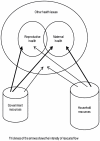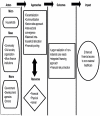Addressing women's non-maternal healthcare financing in developing countries: what can we learn from the experiences of rural Indian women?
- PMID: 22272262
- PMCID: PMC3260165
- DOI: 10.1371/journal.pone.0029936
Addressing women's non-maternal healthcare financing in developing countries: what can we learn from the experiences of rural Indian women?
Abstract
Background and objectives: This paper focuses on the inadequate attention on women's non-maternal healthcare in low- and middle-income countries. The study assessed the purchase of and financial access to non-maternal healthcare. It also scoped for mainstreaming household financial resources in this regard to suggest for alternatives.
Methods: A household survey through multi-stage stratified sampling in the state of Orissa interviewed rural women above 15 years who were neither pregnant nor had any pregnancy-related outcome six weeks preceding the survey. The questions explored on the processes, determinants and outcomes of health seeking for non-maternal ailments. The outcome measures were healthcare access, cost of care and financial access. The independent variables for bivariate and multivariate analyses were contextual factors, health seeking and financing pattern.
Results: The survey obtained a response rate of 98.64% and among 800 women, 43.8% had no schooling and 51% were above 60 years. Each woman reported at least one episode of non-maternal ailment; financial constraints prevented 68% from receiving timely and complete care. Distress coping measures (e.g. borrowings) dominated the financing source (67.9%) followed by community-based measures (32.1%). Only 6% had financial risk-protection; financial risk of not obtaining care doubled for women aged over 60 years (OR 2.00, 95% CI 0.84-4.80), seeking outpatient consultation (OR 2.01, 95% CI 0.89-4.81), facing unfavourable household response (OR 2.04, 95% CI 1.09-3.83), and lacking other financial alternatives (OR 2.13, 95% CI 1.11-4.07). When it comes to timely mobilization of funds and healthcare seeking, 90% (714) of the households preferred maternal care to non-maternal healthcare.
Conclusion: The existing financing options enable sub-optimal purchase of women's non-maternal healthcare. Though dominant, household economy extends inadequate attention in this regard owing to its unfavourable approach towards non-maternal healthcare and limited financial capacity and support from other financial resources.
Conflict of interest statement
Figures
Similar articles
-
Services for women's sexual and reproductive health in India: an analysis of treatment-seeking for symptoms of reproductive tract infections in a nationally representative survey.BMC Womens Health. 2020 Jul 28;20(1):156. doi: 10.1186/s12905-020-01024-3. BMC Womens Health. 2020. PMID: 32723377 Free PMC article.
-
Leveraging community-based financing for women's nonmaternal health care: experiences of rural Indian women.Asia Pac J Public Health. 2015 Mar;27(2):NP1144-60. doi: 10.1177/1010539511433813. Epub 2012 Jan 10. Asia Pac J Public Health. 2015. PMID: 22234831
-
Addressing maternal healthcare through demand side financial incentives: experience of Janani Suraksha Yojana program in India.BMC Health Serv Res. 2012 Sep 15;12:319. doi: 10.1186/1472-6963-12-319. BMC Health Serv Res. 2012. PMID: 22978630 Free PMC article.
-
Demand for Women's Health Services in Northern Nigeria: A Review of the Literature.Afr J Reprod Health. 2017 Jun;21(2):96-108. doi: 10.29063/ajrh2017/v21i2.11. Afr J Reprod Health. 2017. PMID: 29624944 Review.
-
Demand-side financing for maternal and newborn health: what do we know about factors that affect implementation of cash transfers and voucher programmes?BMC Pregnancy Childbirth. 2017 Aug 31;17(1):262. doi: 10.1186/s12884-017-1445-y. BMC Pregnancy Childbirth. 2017. PMID: 28854877 Free PMC article.
Cited by
-
Public healthcare system utilization for chronic hepatitis C infection in Vietnam.BMC Infect Dis. 2023 Nov 16;23(1):802. doi: 10.1186/s12879-023-08726-7. BMC Infect Dis. 2023. PMID: 37974105 Free PMC article.
-
Colonoscopic findings in Peruvian patients with chronic diarrhea.PLoS One. 2012;7(10):e46690. doi: 10.1371/journal.pone.0046690. Epub 2012 Oct 18. PLoS One. 2012. PMID: 23094029 Free PMC article.
-
Payment for Health Care and Perception of the National Health Insurance Scheme in a Rural Area in Southwest Nigeria.Am J Trop Med Hyg. 2015 Sep;93(3):648-54. doi: 10.4269/ajtmh.14-0245. Epub 2015 Jul 20. Am J Trop Med Hyg. 2015. PMID: 26195464 Free PMC article.
-
Access to healthcare and social determinants of health among female migrant beggars in Ibadan, Nigeria.J Migr Health. 2023 Jan 30;7:100160. doi: 10.1016/j.jmh.2023.100160. eCollection 2023. J Migr Health. 2023. PMID: 36798097 Free PMC article.
-
Expanding health insurance scheme in the informal sector in Nigeria: awareness as a potential demand-side tool.Pan Afr Med J. 2017 May 19;27:52. doi: 10.11604/pamj.2017.27.52.11092. eCollection 2017. Pan Afr Med J. 2017. PMID: 28819474 Free PMC article.
References
-
- The World Health Report. Women and health: Today's evidence tomorrow's agenda. 2009. World Health Organization, Geneva. Available: http://whqlibdoc.who.int/publications/2009/9789241563857_eng.pdf. Accessed 2010 July 5.
-
- Sen G. Population and development in South Asia-Did ICPD provide the link? Real Lives. 2001;6:36–49.
-
- United Nations. Millennium Development Goals Report. New York: 2006. The United NationsAvailable: http://unstats.un.org/unsd/mdg//Progress2006/MDGReport2006.pdf. Accessed 2010 June 8.
-
- Gopalan SS. Report on Health equity. 2009. Government of Orissa, Department of H & FW, Bhubaneswar.
-
- Government of India. Mission Document. 2005. National Rural Health Mission. Available: www.mohfw.nic.in/NRHM/Documents/Mission_Document.pdf. Accessed 2009 September 17.
MeSH terms
LinkOut - more resources
Full Text Sources
Medical



